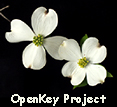
Introduction
Aim of the Project
These web pages and the Intkey interactive key provide resources for identifying and developing botanical knowledge of tree species of the North Carolina Piedmont. The overall aim is to make tree identification more accessible and reliable than is often the case for non-professional botanists using traditional keys.
The tools provided here rely on the use of images to illustrate botanical characters and the features of the species in order to make the identification process more intuitive. The Intkey interactive key, or polyclave, provides flexibility by allowing the user to select from any of approximately 100 plant characters in any order. The polyclave also provides access to notes interpreting the characters and definitions of botanical terms. Using the definitions along with illustrations when selecting character states during the identification process is a valuable way to make identification more reliable. (Detailed notes on the use of the polyclave are provided under 'Basic Features of and Strategies for Using Intkey', accessible within the program.)
Scope
The polyclave and species description pages contain information on 44 trees that occur commonly in natural areas of the Piedmont ecoregion of North Carolina. Most of the trees are native, but two naturalized exotic species are also included. The species are:
| Scientific name | Common name |
| Acer
barbatum Acer negundo Acer rubrum Aesculus sylvatica Albizia julibrissin Betula nigra Carpinus caroliniana Carya alba Carya carolinae-septentrionalis Carya cordiformis Carya glabra Celtis laevigata Cercis Canadensis Cornus florida Fagus grandifolia Fraxinus americana Fraxinus pennsylvanica Juniperus virginiana Liquidambar styraciflua Liriodendron tulipifer Magnolia tripetala Morus rubra Nyssa sylvatica Ostrya virginiana Oxydendrum arboreum Paulownia tomentosa Pinus echinata Pinus taeda Pinus virginiana Platanus occidentalis Prunus serotina Quercus alba Quercus falcata Quercus marilandica Quercus montana Quercus phellos Quercus rubra Quercus stellata Quercus velutina Salix nigra Sassafras albidum Ulmus alata Ulmus Americana Ulmus rubra |
Southern
sugar maple Box elder Red maple Painted buckeye Mimosa River birch American hornbeam Mockernut hickory Southern shagbark hickory Bitternut hickory Pignut hickory Southern hackberry Redbud Flowering dogwood American beech White ash Green ash Eastern red cedar Sweetgum Tuliptree Umbrella magnolia Red mulberry Black gum Hop hornbeam Sourwood Princess tree Shortleaf pine Loblolly pine Virginia pine Sycamore Black cherry White oak Southern red oak Blackjack oak Chestnut oak Willow oak Northern red oak Post oak Black oak Black willow Sassafras Winged elm American elm Slippery elm |
The total number of trees that can be found in the North Carolina Piedmont numbers more than 150 species. (For a comprehensive list of trees that occur in Orange County, NC visit: <http://www.duke.edu/~cwcook/trees/orangetrees.html>.) Thus, some trees you may wish to identify that occur in the region will not be found here.
Data Structure
The data underlying the Intkey polyclave, and used to generate descriptions of the species, are encoded in a Delta database. The full database contains approximately 200 characters commonly used to describe vascular plants. The characters included were chosen for their value in carrying out practical identification, mostly without the use of special equipment such as microscopes. Characters were favored that are readily observable, lend themselves to clear definition and illustration, and tend to be consistently embodied in plants.
Character states were chosen to cover the full range of variation for each character without leaving gaps. The level of detail in character states is intended to permit making distinctions necessary for identification of plants, while avoiding needless complexity. The level of complexity used here, while substantial for those with limited botanical knowledge, reflects what we found necessary to distinguish the species from one another. We hope that the illustrations and access to definitions will help ease the challenge of effective use of the botanical terminology.
Information on the features of each species was recorded by consulting various published sources and, in some cases, herbarium sheets of the taxa. (See the 'References' page.)
The list of characters included in the Intkey polyclave was reduced from the full set to those we found most useful for identifying the 44 trees. However, all applicable characters are included in the detailed descriptions of the species.
Acknowledgements
These pages and the Intkey polyclave were created as part of the OpenKey project, funded by the Institute of Museum and Library Services <http://www.imls.gov>. P. Bryan Heidorn, Ken Robertson and Lesley Deem of the University of Illinois at Urbana Champaign contributed to the creation of the character data structure. Jane Greenberg and Evelyn H. Daniel of the University of North Carolina School of Information and Library Science provided valuable input to numerous aspects of the project. Rebecca Pappert helped format the botanical glossary, and encoded it in a searchable database.
Copyright
Images in the Common Trees of the North Carolina Piedmont polyclave derived from illustrations contained in, Albert E. Radford, William C. Dickison, Jimmy R. Massey, and C. Ritchie Bell, Vascular Plant Systematics, 1974, Harper & Row Publishers (cited here as RDMB), were provided by permission of the authors. All rights are reserved.
All other text and images contained within the University of North Carolina
OpenKey web site <http://www.ibiblio.org/openkey/>
and polyclave may be copied and reused, provided that you:
1) provide attribution citing the author or creator and the location (URL) of
the material in the OpenKey web site, and
2) use the material for noncommercial purposes only.
Any use not in keeping with these two conditions requires the express written
permission of the University of North Carolina Herbarium <http://herbarium.unc.edu>.
Cite this publication as: ‘Stephen M. Seiberling, Alan S. Weakley, and Peter S. White (2005 onwards). Common Trees of the North Carolina Piedmont: Identification, Descriptions, Illustrations, and Glossary. Version: March 7, 2006. < http://www.ibiblio.org/openkey/intkey/>’
Back to Contents